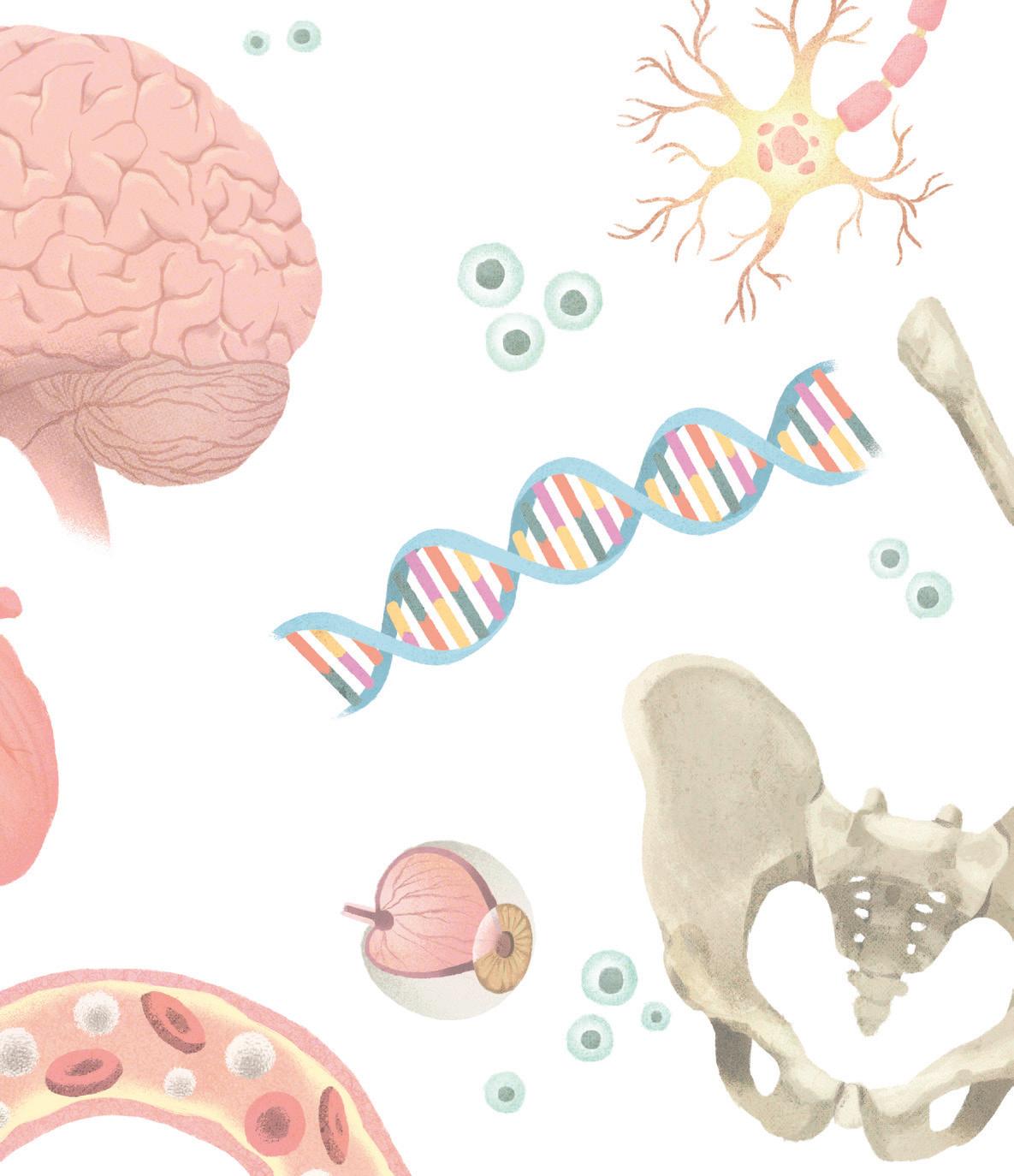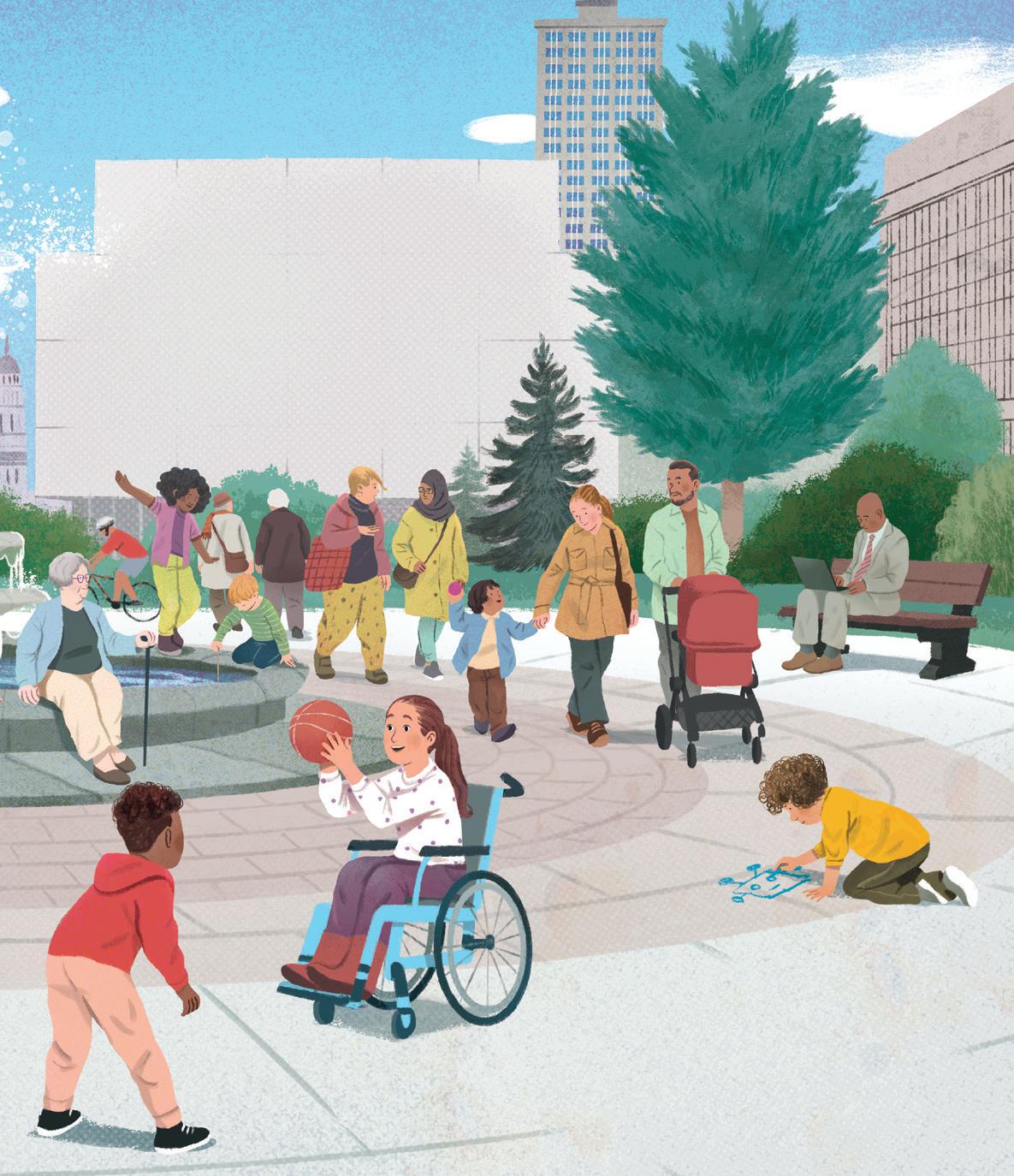












Y.

With respect and admiration to all healthcare workers around the world who worked hard during the Covid 19 pandemic
M. L.
First published 2024 by Nosy Crow Ltd Wheat Wharf, 27a Shad Thames, London, SE1 2XZ
Nosy Crow Eireann Ltd 44 Orchard Grove, Kenmare Co Kerry, V93 FY22, Ireland
www.nosycrow.com
ISBN 978 1 80513 059 8
Nosy Crow and associated logos are trademarks and/or registered trademarks of Nosy Crow Ltd.
Text © Emma Young 2024
Illustrations © Maribel Lechuga 2024
From an original idea developed by Dr Nick Crumpton.
With special thanks to Gill Arbuthnott for her consultation on this book.
The right of Emma Young to be identified as the author and Maribel Lechuga to be identified as the illustrato r o f this work has been asserted.
All rights reserved.
This book is sold subject to the condition that it shall not, by way of trade or otherwise, be lent, hired out or otherwise circulated in any form of binding or cover other than that in which it is published. No part of this publication may be reproduced, stored in a retrieval system, or transmitted in any form or by any means (electronic, mechanical, photocopying, recording or otherwise) without the prior written permission of Nosy Crow Ltd.
The publisher and copyright holders prohibit the use of either text or illustrations to develop any generative machine learning artificial intelligence (AI) models or related technologies.
A CIP catalogue record for this book is available from the British Library. Printed in China following rigorous ethical sourcing standards.
Papers used by Nosy Crow are made from wood grown in sustainable forests.
1 3 5 7 9 8 6 4 2

Introduction
Humans evolved from apes
Every part of your body is human
Doctors know how many organs we have
Identical twins are identical
Neanderthals are completely extinct
Some people are double-jointed
Too much sugar will make you go wild
Your brain can perfectly sense your body
Hypnotism is just a magic trick
It’s easy to tell when someone is dead
Lucky charms don’t work
You only smile when you’re happy
It’s easy to tell when someone wants to be your friend
You only have five senses
Your memory is like a video
Having a bigger brain makes you smarter
Your brain can’t change
You can’t train your brain to be smarter
You need good grades to do well in life
Only your stomach digests food
Eating carrots gives you night-time super-vision
Our fingernails and hair keep growing after we die
The appendix doesn’t do anything
Most of your body heat escapes from your head
We know why we sleep
Nightmares are bad for you
Time can’t slow down or speed up
The
The human body as you know it has been around for about 300,000 years. That ’s the equivalent of you living your entire life three thousand times in a row! Given the incredibly long time that people have lived with their bodies, you might assume that EVERYTHING about them would have been worked out long ago! Um, no. This is not the case.

Every year, brand new discoveries are made. Sometimes, these discoveries teach us more about how parts of our bodies work, or help confirm something that scientists had guessed might be true. But other times, new discoveries totally change ideas about the body and brain – from how many organs we have to why we sleep.
A huge problem is that there are so many MYTHS out there! Some are so popular that you’ve probably been taught them.

Have you ever learned that humans have five senses, or that a smile always means happiness? Maybe you think lucky charms don’t work or that your appendix is pointless? Sorry to say it, but those ideas are myths and therefore . . . wrong
Don’t worry, though, you are far from alone. This book is here to show you that so many things that you know about the human body are wrong. But it is also here to help you learn about amazing new discoveries and facts – the sort that you won’t find in all those other ‘human body’ books on the library shelf!
Curiosity is key to discovering more about the human body. If you’ve ever wondered how hypnosis works, or like the idea of learning about the other life forms inside you, or why time seems to slow down when you’re bored, then this is the book for you!
So, if you want answers to big questions – and to find out where the myths grown-ups tell are going wrong – keep reading . . .
Have you ever seen chimpanzees on a nature documentary? Like humans, they squabble, help their friends, use tools and work together to achieve their goals. Gorillas and orangutans – the other ‘great apes’ – also behave in ways that can seem very similar to ours. In the past, people looked at these apes and saw less developed versions of us. That led some to believe that we are descended from them, but . . . this is absolutely NOT the case!

What was the last shared ancestor of people and other apes like? Based on fossil finds, scientists think it might have climbed slowly through trees, eating fruit. They suspect that it looked a bit like a baby gibbon.
(KNOWN AS ‘LUCY’)
Lucy was what is called an ‘australopith’. Scientists think that true humans – including us – evolved from australopiths like her.
We are related to other apes. In fact, chimpanzees are our closest living relatives. But we did not evolve from them.
Way, way back in time – about seven MILLION years ago – there lived an ape-like animal in Africa. At this point, the evolutionary tree branched. One branch led ultimately to chimps, and one led to modern humans, also known as Homo sapiens , also known as us!
After this forking in the evolutionary tree, it took a long time for us to develop.

Even 3.2 million years ago, our ancestors were still quite a lot like other apes. How do we know? Because we have ‘Lucy’, a very famous partial skeleton from Ethiopia, which dates to this time. Lucy’s brain was smaller than ours and she had long arms, suggesting that she spent quite a bit of time in trees (as chimps do). But Lucy walked on two legs, like us, not on all fours, like chimps.
It’s thought that the first Homo species appeared between about two million and three million years ago! By about 300,000 years ago, Homo sapiens (modern humans) had made their splash on planet Earth. In the meantime, chimps, gorillas, orangutans and other modern apes had all evolved from their own recent ancestors. This makes us all a bit like cousins – but EXTREMELY distant ones!
What if I told you that about 200 grams of your body weight is not actually human at all . . . In fact, TRILLIONS of other life forms, weighing together about as much as one of your KIDNEYS, live inside you!
For every single human cell in your body there’s at least one ‘microbial cell’. They live everywhere, from your nose to your lungs to your bottom. The truth is that you are never, ever alone . . . So what are all these ‘microbes’? Where have they come from? And what are they doing ?
A microbe is so incredibly small that you’ll need an instrument called a microscope to see it. Most of the microbes that live inside you are life forms called ‘bacteria’. Most of the others are ‘fungi’.
The first bacteria to call you home moved in before you were born. Yes, bacteria from your mother made their way into you! You then picked up bacteria from all kinds of other places, including your food, your home, and even your pets.

A mother passes ‘lactobacillus’ bacteria to their newborn. This helps the baby to digest a sugar in milk (called lactose), giving them energy to grow.
Some gut bacteria are hard-working heroes. Among other things, they:
Produce certain vitamins
‘Talk’ to your immune system to help to keep you healthy
Break down fibre from food

‘Good bacteria’ which help keep your body healthy, are also found in your nose and mouth.
NOSE BACTERIA:
Good bacteria living in your nose offer protection from ‘bad bacteria’ trying to get in.

MOUTH BACTERIA:
Some bacteria living in your mouth limit harm to your teeth from acids produced by other bacteria.
Like bacteria, fungi are not animals or plants, but their own special type of life. They live all over and in you – from inside your ears to inside your stomach! Though they can make you unwell, your immune system normally keeps them in check. But wait . . .
It’s not just your insides that are teeming with life. Right now, living inside pores in the skin of your face are tiny creatures called mites. They’re feasting on sebum, the oily substance that stops your skin drying out. Yum . . .
While we think of ourselves as ‘human’ beings, there are countless cells inside you that are not remotely human. You are not really a single life form – but a brilliant human-microbe mix!

What is an ‘organ’ and what does it do? Well, your heart is an organ. So are your lungs, your liver and even your skin! An organ is a bit of your body with a specific important job. Your heart’s job is to pump blood around your body.
There are a few parts of your body that you could easily live without. Your hair? Chop it all off and what’s the worst that could happen?
But your organs are different. If your heart didn’t pump or your lungs stopped working, you’d die. If your skin suddenly vanished, the fatty layer beneath would rub off, and bathwater would soak right into you!
So, knowing exactly which organs we have seems to be pretty crucial.
You might think that doctors in ancient times had a pretty good grip on how many organs we have. I hate to break it to you but they didn't . . . and even within recent history, there have been some spectacular mistakes.
Picture the scene . . . it’s 1960. A woman walks into hospital for an operation and doctors remove her THYMUS GLAND (a gland that sits high up in your chest, between your lungs.) They’re thinking: Who needs it? It does nothing for us . . . Wrong. Wrong. WRONG!

Thymus gland

In 1961, a doctor called Jacques Miller finally realised that in fact the thymus is a CRUCIAL organ. It’s an essential bit of your immune system, which keeps you healthy. Vital immune cells develop in the thymus, and go out from there and fight hard to keep you well.
As well as discovering that body parts thought to be useless are anything but, scientists report the discovery of new organs quite regularly.
In 2018, a team of researchers announced the discovery of the INTERSTITIUM – a squishy network of little spaces filled with liquid.
This network is spread throughout your body. Its job is to be a shock absorber. When muscles move about, it helps to stop organs from tearing.
Tubarial salivary glands
In 2020, doctors in the Netherlands reported the discovery of new organs in our heads ! The TUBARIAL SALIVARY GLANDS sit at the bottom of your skull and empty their liquid out into your throat. The team thinks they are important for swallowing.
Doctors have been arguing for ages about exactly how many organs we have. (Mainly because they can’t agree on what counts as a ‘specific important job’.) Who knows when they’ll agree on a final number?!
